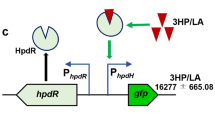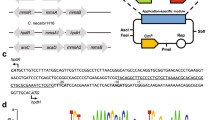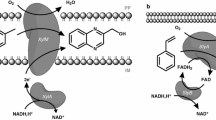Abstract
Novel expression systems for the development of whole-cell biocatalysts were generated. Their novelty consists both in the host, Pseudomonas putida, and in the ability to auto-induce the expression of genes of interest at the exhaustion of the carbon source used for the biomass growth. The auto-induction relies on new expression vectors developed in this study and based on the activator TouR from Pseudomonas sp. OX1, which was shown to mediate the activation of target promoters in an effector-independent growth-phase-dependent manner when the carbon source is exhausted at the onset of the stationary phase. We validated the suitability of these expression systems through the production of (S)-styrene oxide by the styrene monooxygenase from Pseudomonas fluorescens ST. The yields of epoxides produced by these biocatalysts in flask experiments showed to be as efficient as those currently available based on inducible Escherichia coli systems. In addition, a larger scale of biomass production showed no reduction of biocatalysis efficiency. Therefore, the systems developed in this study constitute a valid alternative to current expression systems to use in bioconversion processes.




Similar content being viewed by others
References
Arenghi FL, Pinti M, Galli E, Barbieri P (1999) Identification of the Pseudomonas stutzeri OX1 toluene-o-xylene monooxygenase regulatory gene (touR) and of its cognate promoter. Appl Environ Microbiol 65:4057–4063
Arenghi FL, Berlanda D, Galli E, Sello G, Barbieri P (2001) Organization and regulation of meta cleavage pathway genes for toluene and o-xylene derivative degradation in Pseudomonas stutzeri OX1. Appl Environ Microbiol 67:3304–3308
Beltrametti F, Marconi AM, Bestetti G, Colombo C, Galli E, Ruzzi M, Zennaro E (1997) Sequencing and functional analysis of styrene catabolic genes from Pseudomonas fluorescens ST. Appl Environ Microbiol 63:2232–2239
Bertoni G, Bolognese F, Galli E, Barbieri P (1996) Cloning of the genes and characterization of the early stages of toluene and o-xylene catabolism in Pseudomonas stutzeri OX1. Appl Environ Microbiol 62:3704–3711
Bestetti G, Di Gennaro P, Colmegna A, Ronco I, Galli E, Sello G (2004) Characterization of styrene catabolic pathway in Pseudomonas fluorescens ST. Int Biodet and Biodeg 54:183–187
Buhler B, Schmid A (2004) Process implementation aspects for biocatalytic hydrocarbon oxyfunctionalization. J Biotechnol 113:183–210
Buhler B, Witholt B, Hauer B, Schmid A (2002) Characterization and application of xylene monooxygenase for multistep biocatalysis. Appl Environ Microbiol 68:560–568
Chen Q, Janssen DB, Witholt B (1996) Physiological changes and alk gene instability in Pseudomonas oleovorans during induction and expression of alk genes. J Bacteriol 178:5508–5512
Davies HG, Green RH, Kelly DR, Roberts SM (1989) Biotransformations in preparative organic chemistry: the use of isolated enzymes and whole cell systems in synthesis. Academic, London
de Lorenzo V, Herrero M, Jakubzik U, Timmis KN (1990) Mini-Tn5 derivatives for insertion mutagenesis, promoter probing, and chromosomal insertion of cloned DNA in gram-negative eubacteria. J Bacteriol 172:6568–6572
Di Gennaro P, Colmegna A, Galli E, Sello G, Pelizzoni F, Bestetti G (1999) A new biocatalyst for production of optically pure aryl epoxides by styrene monooxygenase from Pseudomonas fluorescens ST. Appl Environ Microbiol 65:2794–2797
Duetz WA, van Beilen JB, Witholt B (2001) Using proteins in their natural environment: potential and limitations of microbial whole-cell hydroxylations in applied biocatalysis. Curr Opin Biotechnol 12:419–425
Ensley BD, Ratzkin BJ, Osslund TD, Simon MJ, Wackett LP, Gibson DT (1983) Expression of naphthalene oxidation genes in Escherichia coli results in the biosynthesis of indigo. Science 222:167–169
Faber K (2004) Biotransformations in organic chemistry. Springer, Berlin
Franklin FC, Williams PA (1980) Construction of a partial diploid for the degradative pathway encoded by the TOL plasmid (pWWO) from Pseudomonas putida mt-2: evidence for the positive nature of the regulation by the xyIR gene. Mol Gen Genet 177:321–328
Hack CJ, Woodley JM, Lilly MD, Liddell JM (2000) Design of a control system for biotransformation of toxic substrates: toluene hydroxylation by Pseudomonas putida UV4. Enz Microbiol Technol 26:530–536
Lee K (1999) Benzene-induced uncoupling of naphthalene dioxygenase activity and enzyme inactivation by production of hydrogen peroxide. J Bacteriol 181:2719–2725
Lehmeier B, Amann E (1992) Tac promoter vectors incorporating the bacteriophage T7 gene 10 translational enhancer sequence for improved expression of cloned genes in Escherichia coli. J Biotechnol 23:153–165
Miller JH (1972) Experiments in molecular genetics. Cold Spring Harbor Edition, New York
Nakazawa T (2002) Travels of a Pseudomonas, from Japan around the world. Environ Microbiol 4:782–786
O’Connor KE, Dobson ADW, Hartmans S (1997) Indigo formation by microorganisms expressing styrene monooxygenase activity. Appl Environ Microbiol 63(11):4287–4291
Olins PO, Devine CS, Rangwala SH, Kavka KS (1988) The T7 phage gene 10 leader RNA, a ribosome-binding site that dramatically enhances the expression of foreign genes in Escherichia coli. Gene 73:227–235
Ozbudak EM, Thattai M, Lim HN, Shraiman BI, van Oudenaarden A (2004) Multistability in the lactose utilization network of Escherichia coli. Nature 42:737–740
Panke S, de Lorenzo V, Kaiser A, Witholt B, Wubbolts MG (1999) Engineering of a stable whole-cell biocatalyst capable of (S)-styrene oxide formation for continuous two-liquid-phase applications. Appl Environ Microbiol 65(12):5619–5623
Panke S, Wubbolts MG, Witholt B (2000) Production of enantiopure styrene oxide by recombinant Escherichia coli synthesizing a two-component styrene monooxygenase. Biotechnol Bioeng 69:91–100
Park JB, Buhler B, Habicher T, Bernhard H, Panke S, Witholt B, Schmid A (2006) The efficiency of recombinant Escherichia coli as biocatalyst for stereospecific epoxidation. Biotechnol Bioeng 95:501–512
Park JB, Buhler B, Panke S, Witholt B, Schmid A (2007) Carbon metabolism and product inhibition determine the epoxidation efficiency of solvent tolerant Pseudomonas sp. strain VLB120ΔC. Biotechnol Bioeng 98(6):1219–1229
Ramos JL, Duque E, Gallegos MT, Godoy P, Ramos-Gonzalez MI, Rojas A (2002) Mechanisms of solvent tolerance in gram-negative bacteria. Annu Rev Microbiol 56:743–768
Ramos-Gonzalez MI, Ben-Bassat A, Campos MJ, Ramos JL (2003) Genetic engineering of a highly solvent-tolerant Pseudomonas putida strain for biotransformation of toluene to p-hydroxybenzoate. Appl Environ Microbiol 69:5120–5127
Sambrook J, Russel D (2000) Molecular cloning: a laboratory manual. Cold Spring Harbor Laboratory Press, Cold Spring Harbor
Sambrook J, Fritsch EF, Maniatis T (1989) Molecular cloning: a laboratory manual. Cold Spring Harbor Laboratory Press, Cold Spring Harbor
Shingler V, Bartilson M, Moore T (1993) Cloning and nucleotide sequence of the gene encoding the positive regulator (DmpR) of the phenol catabolic pathway encoded by pVI150 and identification of DmpR as a member of the NtrC family of transcriptional activators. J Bacteriol 175:1596–1604
Solera D, Arenghi FLG, Woelk T, Galli E, Barbieri P (2004) TouR-mediated effector-independent growth phase-dependent activation of the sigma 54 Ptou promoter of Pseudomonas stutzeri OX1. J Bacteriol 186:7353–7363
Staijen IE, van Beilen JB, Witholt B (2000) Expression, stability and performance of the three-component alkane mono-oxygenase of Pseudomonas oleovorans in Escherichia coli. Eur J Biochem 267:1957–1965
Studholme DJ, Dixon R (2003) Domain architectures of sigma54-dependent transcriptional activators. J Bacteriol 185:1757–1767
Studier FW (2005) Protein production by auto-induction in high-density shaking cultures. Protein Expr Purif 41:207–234
Sze CC, Bernardo LMD, Shingler V (2002) Integration of global regulation of two aromatic-responsive σ54-dependent systems: a common phenotype by different mechanisms. J Bacteriol 184:760–770
Witholt B, Favre-Bull O, Lageveen R, Kingma J, van Beilen JB, Marvin H, Preusting H (1992) Synthesis of apolar organic compounds by Pseudomonas spp. and Escherichia coli in two-liquid-phase fermentations. In: Galli E, Silver S, Witholt B (eds) Pseudomonas: molecular biology and biotechnology. ASM, Washington, pp 301–314
Wubbolts MG, Hoven J, Melgert B, Witholt B (1994) Efficient production of optically active styrene epoxides in two-liquid phase cultures. Enz Microbiol Technol 16:887–894
Wubbolts MG, Favrebulle O, Witholt B (1996) Biosynthesis of synthons in two-liquid-phase media. Biotechnol Bioeng 52:301–308
Yanish-Perron C, Vieira J, Messing J (1985) Improved M13 phage cloning vectors and host strains: nucleotide sequences of the M13mp18 and pUC19 vectors. Gene 33:103–119
Acknowledgments
This work was supported by Grants from MIUR-PRIN 2004 “Biocatalytic process development to produce bioproducts of interest”. We thank A. Baratto and V. Vigano’ for technical support and P. Barbieri for helpful discussion.
Author information
Authors and Affiliations
Corresponding author
Rights and permissions
About this article
Cite this article
Di Gennaro, P., Ferrara, S., Bestetti, G. et al. Novel auto-inducing expression systems for the development of whole-cell biocatalysts. Appl Microbiol Biotechnol 79, 617–625 (2008). https://doi.org/10.1007/s00253-008-1460-z
Received:
Revised:
Accepted:
Published:
Issue Date:
DOI: https://doi.org/10.1007/s00253-008-1460-z




